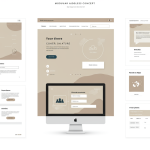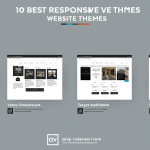
Your website’s theme is more than just a color scheme or a layout—it’s the digital foundation that reflects your brand’s identity, engages your audience, and supports your content strategy. Whether you’re building a personal blog, an e-commerce store, or a corporate portal, selecting the right theme can make or break your online presence. A well-designed theme not only captivates visitors aesthetically but also influences how they interact with your content. According to a recent study, 94% of first impressions are design-related. That means if your theme doesn’t resonate with users immediately, you risk losing potential customers within seconds. In this comprehensive guide, we’ll walk you through everything you need to know to choose and implement the perfect website theme for your next project, covering design considerations, performance metrics, SEO optimization, and top theme recommendations
Understanding the Role of Website Themes

At its core, a website theme controls the visual design and layout of your site by defining how your content is displayed, how navigation is structured, and which design elements—such as typography, color palettes, and imagery—are consistently applied across pages. Themes are often pre-packaged with template files, style sheets, and supporting scripts that determine the look and feel of every section. Think of your theme as a digital skeleton and skin: it provides structure while delivering the aesthetic appeal that will either delight your audience or drive them away. Beyond aesthetics, well-coded themes incorporate accessibility standards, search engine friendly markup, and compatibility with essential plugins, ensuring your site performs reliably as it grows. learn more about 10 Best Responsive Website Themes.
Types of Website Themes
When it comes to website themes, one size does not fit all. Depending on your industry, content strategy, and technical requirements, you might opt for a theme that caters to specific needs. Here are some common categories:
- Multipurpose Themes: Offer extensive customization options, multiple layout templates, and modular components. Ideal for agencies or freelancers who work on diverse projects.
- Niche-Specific Themes: Tailor-made solutions for particular sectors such as restaurants, hotels, photography portfolios, or real estate listings. These themes often include demos and features geared toward the niche’s unique requirements.
- Minimalist Themes: Focus on simplicity and content-first presentation. With whitespace, clean typography, and subtle animations, they guarantee fast load times and minimal distractions.
- eCommerce Themes: Designed for online stores and marketplaces. They typically include product galleries, shopping cart functionality, checkout page designs, and integration with payment gateways.
- Blog and Magazine Themes: Emphasize readability and content organization. Features like featured posts sliders, category grids, and social sharing buttons help increase engagement and time on site.
- Portfolio Themes: Perfect for creatives—photographers, designers, artists. They highlight visual content with galleries, lightboxes, and fullscreen slideshows.
Choosing the right category helps narrow down your options and focus on themes that are built to meet your objectives out of the box.
Key Features to Look For
Not all themes are created equal. Below are essential features you should prioritize:
- Design Flexibility: Look for themes with flexible header and footer builders, multiple widget areas, and customizable page templates.
- Built-In Page Builders: Drag-and-drop interfaces like Elementor, Gutenberg-compatible blocks, or proprietary builders simplify design adjustments without coding.
- SEO Optimization: Themes should use clean, semantic HTML5 markup and support schema.org structured data. Compatibility with SEO plugins like Yoast or Rank Math is a must.
- Performance: A good theme minimizes HTTP requests, uses optimized CSS and JS files, and supports GZIP compression and CDN integration.
- Accessibility: Compliance with WCAG (Web Content Accessibility Guidelines) ensures your site is usable by people with disabilities.
- Security: Well-maintained themes adhere to platform coding standards and avoid security vulnerabilities.
- Translation and Multilingual Support: Ensure compatibility with translation plugins and right-to-left (RTL) languages if necessary.
- Regular Updates and Support: Check the developer’s track record for timely updates, changelogs, and active support forums or ticket systems.
Responsive Design and Mobile Optimization
Today, mobile devices account for over 50% of global web traffic. A responsive theme dynamically adjusts layouts, images, and navigation menus to deliver a seamless user experience on any device. Important responsive features include:
- Fluid Grids: Flexible column structures that resize proportionally.
- Adaptive Images: Techniques like srcset and picture elements to serve appropriately sized images to different viewports.
- Touch-Friendly Navigation: Mobile-friendly menus, swipe gestures, and tappable elements with sufficient spacing.
- Viewport Meta Tag: Ensures proper scaling on mobile browsers.
Always test theme demos on various devices and use tools like Google’s Mobile-Friendly Test and BrowserStack to catch layout issues early.
Performance and SEO Considerations
Fast load times not only improve user engagement but also boost search engine rankings. Here’s what to look for:
- Minimal and Clean Code: Avoid themes loaded with bloat. Examine source code for unnecessary inline styles and redundant scripts.
- Optimized Assets: Built-in lazy loading for images and videos, and support for modern formats like WebP.
- Advanced Caching: Compatibility with caching plugins such as WP Rocket, W3 Total Cache, or platform-specific solutions.
- Schema Markup: Integrated support for rich snippets to enhance search result appearance.
- Performance Scores: Check demo theme’s performance using Lighthouse, GTmetrix, or Pingdom. Look for high scores in Performance, Accessibility, Best Practices, and SEO categories.
Progressive Web App (PWA) and Future-Proofing
As web technologies evolve, Progressive Web Apps (PWAs) are becoming essential for delivering app-like experiences on the web. Some modern themes offer built-in PWA support or compatibility with PWA plugins. This ensures features like offline access, push notifications, and home-screen installation, which can significantly enhance user engagement and retention. When selecting a theme, look for documentation or demos showcasing PWA integration to future-proof your site.
Customization and Flexibility
Your chosen theme should serve as a starting point rather than a rigid template. Key aspects include:
- Global Styles Control: Centralized panels to customize global fonts, color palettes, and button styles.
- Custom CSS and Code Snippets: Options to safely add or override styles and scripts without altering core theme files.
- Widgets and Sidebars: Multiple widget-ready areas for custom content like calls to action, social feeds, and recent posts.
- Custom Post Types and Templates: Support for portfolio items, testimonials, or services with dedicated template designs.
- Child Theme Ready: Built-in compatibility to create child themes, preserving customizations during parent theme updates.
Compatibility with Plugins and Platforms
Ensure your theme integrates seamlessly with the tools and platforms you rely on. Verify compatibility with:
- Page Builders: Elementor, WPBakery, Beaver Builder, or Gutenberg block-based builders.
- SEO Plugins: Yoast, All in One SEO Pack, Rank Math.
- eCommerce Solutions: WooCommerce, Easy Digital Downloads, Shopify themes (for Shopify stores).
- Multilingual and Translation: WPML, Polylang, Weglot.
- Membership and LMS: LearnDash, LifterLMS, MemberPress.
Check theme documentation for tested integrations and known issues to avoid plugin conflicts down the road.
Best Practices for Theme Implementation
Following these best practices helps ensure a successful theme launch:
- Use a Staging Environment: Mirror your live site on a test server to safely experiment with new themes and updates.
- Backup Your Site: Regular backups using tools like UpdraftPlus or VaultPress safeguard against data loss.
- Customize with a Child Theme: Implement customizations in a child theme to keep parent theme updates intact.
- Performance Audits: Run regular audits using Lighthouse or GTmetrix and address performance bottlenecks.
- Accessibility Testing: Use automated tools like WAVE and manual keyboard-navigation tests to ensure compliance.
- Gather User Feedback: Heatmaps, session recordings, and surveys can provide insights into how users interact with your new design.
Top Recommendations
Here are some standout themes that excel in design, performance, and customization:
- Astra: Under 50KB, highly modular, compatible with major builders, and optimized for speed.
- OceanWP: Feature-rich free version, deep WooCommerce integration, and multiple demo sites.
- GeneratePress: Lightweight, accessibility-ready, with extensive hook system for advanced customization.
- Divi: Powerful visual builder, global elements, and a large community of third-party layouts and plugins.
- Neve: Mobile-first design, AMP-ready, and seamless integration with Gutenberg and Elementor.
- Blocksy: Modern Gutenberg theme with dynamic header builder, responsive controls, and custom sidebars.
Additional Resources and Tools

To streamline your theme selection and implementation process, consider leveraging these resources:
- ThemeForest and WordPress.org Theme Directory for diverse theme options.
- Color Hunt and Google Fonts for design inspiration.
- PageSpeed Insights and Web Dev Measure for performance testing.
- W3C WAI Accessibility Evaluation for compliance checks.
- Can I Use for browser compatibility data.
Conclusion
Choosing the perfect website theme involves balancing aesthetics, performance, and functionality. By prioritizing responsive design, clean code, SEO optimization, and robust customization options, you’ll set your project up for long-term success. Use the insights and recommendations in this guide to make an informed decision and deliver an exceptional user experience. Remember: the right theme is the foundation of your digital presence, so choose wisely and always keep your audience in mind.
















No Comments